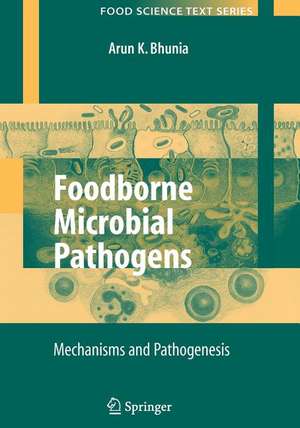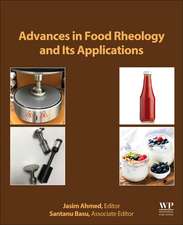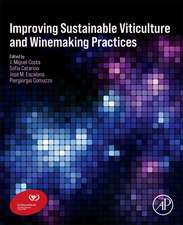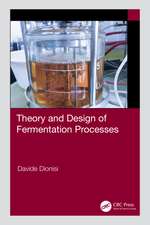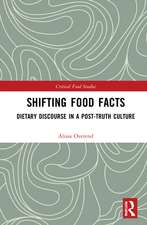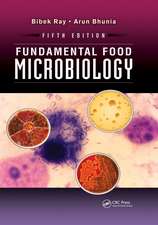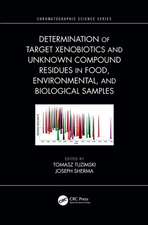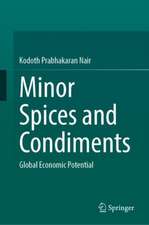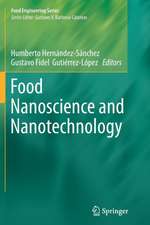Foodborne Microbial Pathogens: Mechanisms and Pathogenesis: Food Science Text Series
Autor Arun Bhuniaen Limba Engleză Paperback – 25 noi 2010
| Toate formatele și edițiile | Preț | Express |
|---|---|---|
| Paperback (1) | 392.37 lei 6-8 săpt. | |
| Springer – 25 noi 2010 | 392.37 lei 6-8 săpt. | |
| Hardback (1) | 381.57 lei 38-44 zile | |
| Springer – 12 dec 2007 | 381.57 lei 38-44 zile |
Din seria Food Science Text Series
- 17%
 Preț: 502.95 lei
Preț: 502.95 lei - 17%
 Preț: 469.18 lei
Preț: 469.18 lei - 15%
 Preț: 549.39 lei
Preț: 549.39 lei - 20%
 Preț: 579.80 lei
Preț: 579.80 lei -
 Preț: 458.78 lei
Preț: 458.78 lei - 15%
 Preț: 566.10 lei
Preț: 566.10 lei - 13%
 Preț: 358.75 lei
Preț: 358.75 lei - 15%
 Preț: 635.75 lei
Preț: 635.75 lei -
 Preț: 396.40 lei
Preț: 396.40 lei -
 Preț: 482.23 lei
Preț: 482.23 lei -
 Preț: 398.35 lei
Preț: 398.35 lei - 15%
 Preț: 508.60 lei
Preț: 508.60 lei - 15%
 Preț: 508.75 lei
Preț: 508.75 lei - 15%
 Preț: 587.39 lei
Preț: 587.39 lei - 18%
 Preț: 965.83 lei
Preț: 965.83 lei -
 Preț: 393.13 lei
Preț: 393.13 lei - 15%
 Preț: 532.70 lei
Preț: 532.70 lei - 15%
 Preț: 593.26 lei
Preț: 593.26 lei -
 Preț: 474.31 lei
Preț: 474.31 lei - 15%
 Preț: 658.05 lei
Preț: 658.05 lei - 15%
 Preț: 600.74 lei
Preț: 600.74 lei - 18%
 Preț: 971.22 lei
Preț: 971.22 lei - 15%
 Preț: 477.74 lei
Preț: 477.74 lei - 18%
 Preț: 1010.33 lei
Preț: 1010.33 lei - 15%
 Preț: 477.74 lei
Preț: 477.74 lei - 15%
 Preț: 574.25 lei
Preț: 574.25 lei
Preț: 392.37 lei
Nou
Puncte Express: 589
Preț estimativ în valută:
75.08€ • 78.60$ • 62.12£
75.08€ • 78.60$ • 62.12£
Carte tipărită la comandă
Livrare economică 05-19 aprilie
Preluare comenzi: 021 569.72.76
Specificații
ISBN-13: 9781441925626
ISBN-10: 1441925627
Pagini: 296
Ilustrații: XVIII, 276 p.
Dimensiuni: 178 x 254 x 16 mm
Greutate: 0.52 kg
Ediția:2008
Editura: Springer
Colecția Springer
Seria Food Science Text Series
Locul publicării:New York, NY, United States
ISBN-10: 1441925627
Pagini: 296
Ilustrații: XVIII, 276 p.
Dimensiuni: 178 x 254 x 16 mm
Greutate: 0.52 kg
Ediția:2008
Editura: Springer
Colecția Springer
Seria Food Science Text Series
Locul publicării:New York, NY, United States
Public țintă
GraduateCuprins
to Foodborne Pathogens.- Biology of Microbes Associated with Food.- Host Defense Against Foodborne Pathogens.- General Mechanism of Pathogenesis for Foodborne Pathogens.- Animal and Cell Culture Models to Study Foodborne Pathogen Interaction.- Staphylococcus aureus.- Bacillus cereus and Bacillus anthracis.- Clostridium botulinum and Clostridium perfringens.- Listeria monocytogenes.- Escherichia coli.- Salmonella enterica.- Campylobacter and Arcobacter.- Yersinia enterocolitica and Yersinia pestis.- Vibrio cholerae, V. parahaemolyticus, V. vulnificus.- Shigella species.
Recenzii
From the reviews:
"A well-organized work covering a variety of foodborne microorganisms. … Figures and tables are used well throughout the book to illustrate topics, and references are included at the end of each chapter. Readers without a thorough knowledge of immunology and microbiology will find this a useful resource, as the author provides enough information for them to understand the concepts presented. Summing Up: Recommended. General readers; lower-division undergraduates." (P. M. Watt, CHOICE, Vol. 45 (11), August, 2008)
"A well-organized work covering a variety of foodborne microorganisms. … Figures and tables are used well throughout the book to illustrate topics, and references are included at the end of each chapter. Readers without a thorough knowledge of immunology and microbiology will find this a useful resource, as the author provides enough information for them to understand the concepts presented. Summing Up: Recommended. General readers; lower-division undergraduates." (P. M. Watt, CHOICE, Vol. 45 (11), August, 2008)
Notă biografică
Arun K. Bhunia, B.V.Sc., Ph.D., is a professor of molecular food microbiology in the Department of Food Science at Purdue University, West Lafayette, Indiana. Prof. Bhunia received his PhD from University of Wyoming. He received his Bachelor of Veterinary Medicine degree from Bidhan Chandra Krishi Viswa Vidyalaya (currently West Bengal University of Fishery and Animal Sciences), West Bengal, India. He received his postdoctoral training from University of Arkansas, Fayetteville, AR, in 1994 and then joined Alabama A&M University as an Assistant Professor in 1995. In 1998, he joined the Department of Food Science at Purdue University. He teaches two graduate level courses: Microbial Foodborne Pathogen – this course deals with mechanism of pathogenesis of foodborne pathogens and toxins and the host immune response to infections. Microbial Techniques for Food Pathogen is a laboratory course that incorporates rapid methods employing immunoassays, genetic and biosensor tools. In addition, he co-directs a graduate level seminar course - "Gut Microbiology Journal Club. He conducts research in the area of foodborne pathogens with major emphasis on pathogen detection utilizing biosensor, cell-based sensor, immunosensor, immunoassays and genetic tools. The primary target organisms are Listeria monocytogenes, Escherichia coli, Salmonella, and Bacillus cereus. In addition, he conducts research to investigate pathogenic mechanism especially the intestinal phase of infection for Listeria monocytogenes. He is also involved in developing mammalian cell culture-based rapid assays for foodborne pathogens. His research has been funded by grants from US Department of Agriculture, National Science Foundation, and Center for Food Safety Engineering at Purdue University.
To date, Prof. Bhunia has published 86 refereed and 21 proceedings articles, coauthored a text book "Fundamental Food Microbiology,4th Edition, CRC Press, and co-edited two books (Foodborne Pathogens: Microbiology and Molecular Biology, 2005; Caister Academic Press, and The Science of Homeland Security, 2006, Purdue University Press). He has written eight book chapters, and presented over 100 presentations in national and international meetings or institutions. He is a member of American Association for the Advancement of Science, American Society for Microbiology, Institute of Food Technologists, and Society for Photo Optical Engineers, and he currently serves as editorial board member for two refereed journals; Journal of Food Protection, Journal of Food, Agriculture and Environment. In 2003, Prof. Bhunia received a prestigious Purdue Agricultural Research Award, in 2005, he was selected as University Faculty Scholar and his research team received "2006 Agriculture Team Award" from Purdue University.
To date, Prof. Bhunia has published 86 refereed and 21 proceedings articles, coauthored a text book "Fundamental Food Microbiology,4th Edition, CRC Press, and co-edited two books (Foodborne Pathogens: Microbiology and Molecular Biology, 2005; Caister Academic Press, and The Science of Homeland Security, 2006, Purdue University Press). He has written eight book chapters, and presented over 100 presentations in national and international meetings or institutions. He is a member of American Association for the Advancement of Science, American Society for Microbiology, Institute of Food Technologists, and Society for Photo Optical Engineers, and he currently serves as editorial board member for two refereed journals; Journal of Food Protection, Journal of Food, Agriculture and Environment. In 2003, Prof. Bhunia received a prestigious Purdue Agricultural Research Award, in 2005, he was selected as University Faculty Scholar and his research team received "2006 Agriculture Team Award" from Purdue University.
Textul de pe ultima copertă
Foodborne Microbial Pathogens: Mechanisms and Pathogenesis is the first textbook of its kind, and will serve as a valuable resource not only for food microbiology graduate or undergraduate students but can be used as a desk reference for medical microbiologists, microbiology professionals, and academicians involved in food microbiology and food safety related research or teaching.
The author presents up-to-date information on molecular and cellular mechanism of several major foodborne microbial pathogens, including select agents for bioterrorism, virulence genes and their regulation in the host or the food environment, pathogenicity testing models, clinical symptoms, and prevention and control strategies. In order to understand the disease process, one must have certain understanding about the role of the immune system. Thus this book also covers the host parasite interaction to a level where the readers will have a better appreciation for the disease mechanism.
The book also includes digital and hand-drawn figures to illustrate the pathogenic process. The art was generated by the author, and the illustrations uniquely aid in better understanding of the mechanism of pathogenesis.
About the Author:
Arun K. Bhunia is a Professor of Molecular Food Microbiology at Purdue University, West Lafayette, Indiana
The author presents up-to-date information on molecular and cellular mechanism of several major foodborne microbial pathogens, including select agents for bioterrorism, virulence genes and their regulation in the host or the food environment, pathogenicity testing models, clinical symptoms, and prevention and control strategies. In order to understand the disease process, one must have certain understanding about the role of the immune system. Thus this book also covers the host parasite interaction to a level where the readers will have a better appreciation for the disease mechanism.
The book also includes digital and hand-drawn figures to illustrate the pathogenic process. The art was generated by the author, and the illustrations uniquely aid in better understanding of the mechanism of pathogenesis.
About the Author:
Arun K. Bhunia is a Professor of Molecular Food Microbiology at Purdue University, West Lafayette, Indiana
Caracteristici
For the first time a book will link foodborne illness and immunology This textbook will combine the host parasite interaction to a level where the readers would have better appreciation for the disease mechanism with up-to-date information on molecular and cellular mechanism of several major foodborne bacterial pathogens, virulence genes and their regulation in the host or the food environment, pathogenicity testing models, clinical symptoms and prevention and control strategies Includes supplementary material: sn.pub/extras Request lecturer material: sn.pub/lecturer-material
